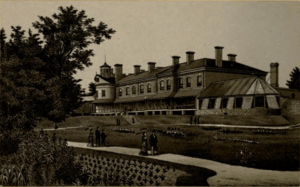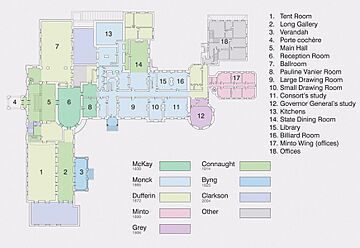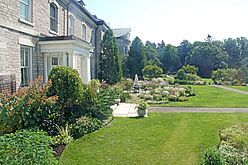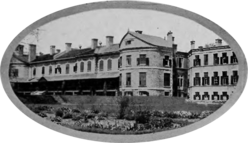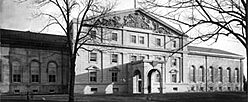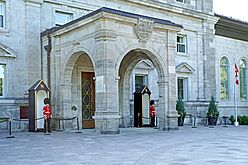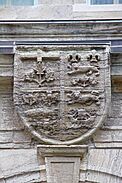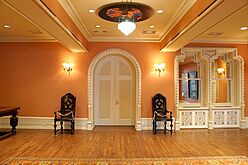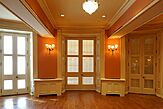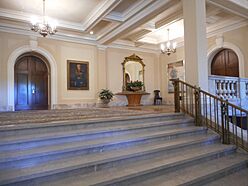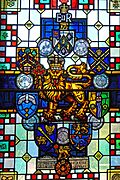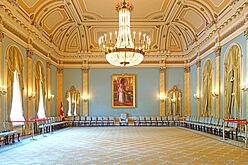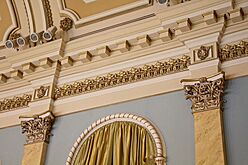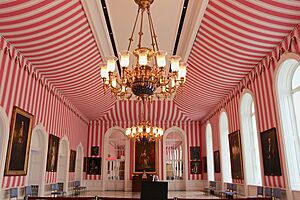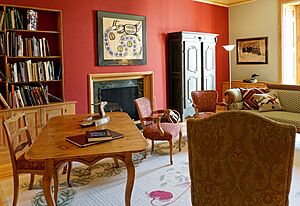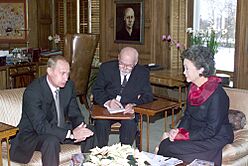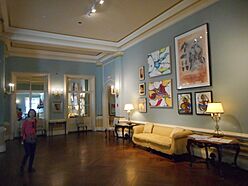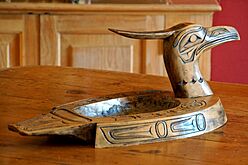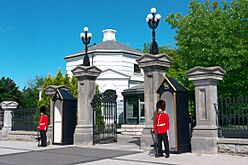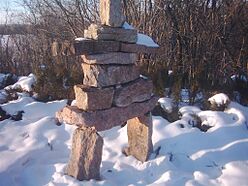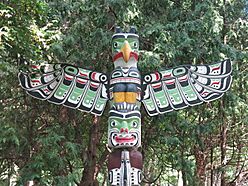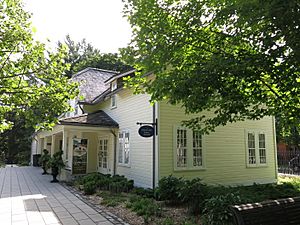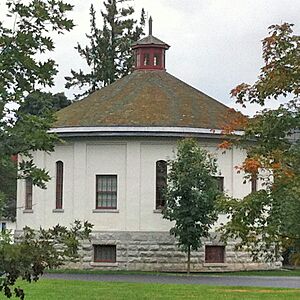Rideau Hall facts for kids
Quick facts for kids Government House |
|
|---|---|
|
Rideau Hall
|
|
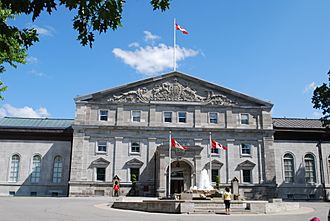
Main façade of Government House
|
|
| General information | |
| Architectural style | Regency, Norman Revival, Florentine Renaissance Revival |
| Address | 1 Sussex Dr. |
| Town or city | Ottawa, Ontario |
| Country | Canada |
| Coordinates | 45°26′38″N 75°41′08″W / 45.443753°N 75.685641°W |
| Construction started | 1838 |
| Cost | $82,000 (1868) |
| Client | Thomas McKay (1838), The Crown in Right of Canada (1865, 1872, 1899, 1906, 1914, 1925, 2004) |
| Owner | The King in Right of Canada |
| Landlord | National Capital Commission |
| Technical details | |
| Size | 9,500 m2 (102,000 sq ft) |
| Design and construction | |
| Architect | Thomas McKay, David Ewart, etc. |
| Other information | |
| Number of rooms | ≈ 175 |
| Designated: | 1977 |
Rideau Hall is the official home of the governor general of Canada. The governor general is the King's representative in Canada. This important building is also known as Government House. It is located in Ottawa, the capital city of Canada.
The estate covers about 88 acres (36 hectares) at 1 Sussex Drive. The main building has around 175 rooms. It covers about 9,500 square metres (102,000 square feet). There are also 27 smaller buildings on the grounds. Rideau Hall is one of two official homes for the King's representative. The other is the Citadelle of Quebec. The King of Canada also stays here when he visits Canada.
Most of Rideau Hall is used for official government business. Only a small part, about 500 square metres (5,400 square feet), is for private living. The offices of the Canadian Heraldic Authority are also here. This is where the governor general and their team work. Important visitors like foreign leaders and ambassadors are welcomed at Rideau Hall. Canadian government ministers also meet with the governor general or the King here.
Many Canadian awards are given out at Rideau Hall. New prime ministers and other government members are sworn in here. Important election documents are also officially presented here. Rideau Hall and its grounds became a National Historic Site of Canada in 1977. The house is open for public tours all year. About 200,000 people visit Rideau Hall every year. Since 1934, the National Capital Commission has taken care of the grounds.
Contents
What's in a Name?
The name Rideau Hall was chosen by Thomas McKay for his home. He was inspired by the Rideau Canal, which he helped build. People also sometimes called it McKay's Castle. When it became the official home for the governor general, it was formally called Government House.
However, Rideau Hall remained the common name. This caused some confusion. In 1889, Queen Victoria even told the governor general's wife not to call it Rideau Hall. She said it should be Government House, like in other parts of the British Empire. Today, Rideau Hall is the name most people use. Government House is still used for very formal or legal documents.
History of Rideau Hall
McKay's First Home
The land for Rideau Hall was chosen by Thomas McKay. He was a stonemason who came to Canada in 1817. McKay was the main builder of the Rideau Canal. After the canal was finished, he built mills near Rideau Falls. This made him the founder of New Edinburgh, a neighbourhood in Ottawa.
With his new wealth, McKay bought 100 acres (40 hectares) of land. It overlooked both the Ottawa and Rideau Rivers. In 1838, he built a stone house there. This house became the beginning of today's Rideau Hall. McKay and his family lived there until 1855. Locals often called his home McKay's Castle.
Even before it was the governor general's home, important people visited. Three governors general of the Province of Canada stayed there. It is said that drawings of Barrack Hill (now Parliament Hill) by Lady Head, a governor's wife, helped Queen Victoria choose Ottawa as the capital. In 1860, Prince Edward (who later became King Edward VII) also visited the grounds.
Becoming the Governor General's Home

In 1864, the government rented Rideau Hall from the McKay family. It cost $4,000 a year. The plan was for it to be a temporary home for the governor general. A new, proper government house was supposed to be built later. The next year, Frederick Preston Rubidge oversaw changes to the house. He added new parts to make it three or four times bigger.
The first Governor General of Canada, the Viscount Monck, moved in after the changes. Some people, like George Brown, thought the house was too small. Prime Minister John A. Macdonald also felt too much money was spent fixing it up. Despite this, the government bought the property in 1868 for $82,000.
Rideau Hall then became a very important social place in Ottawa. It hosted foreign visitors, award ceremonies, parties, and plays. The governor general and his family often took part in these events. A very large costume ball was held in 1876. About 1,500 guests attended this event.
Early visitors sometimes found Rideau Hall a bit disappointing. In 1872, the Countess of Dufferin said it "did lower our spirits just a little!" In 1893, Lady Stanley described the furniture as "very old-fashioned." She also said the rooms were "very empty" and lacked small comforts.
Over the years, many improvements were made. Gas lights and a telegraph wire were added. A large ballroom was built in 1872. By 1878, when Princess Louise, the King's daughter, moved in, many upgrades were complete. She found the house "big and comfortable."
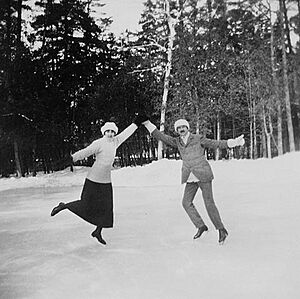
Members of the royal family often stayed at Rideau Hall. They visited as guests or as governors general. Many princes and princesses stayed there over the years. This included Prince George (later King George V) and Prince Albert (later King George VI).
In 1943, Alastair Windsor, 2nd Duke of Connaught and Strathearn, a grandson of a former governor general, passed away on the grounds. He was found in his room.
Second World War and Royal Visits
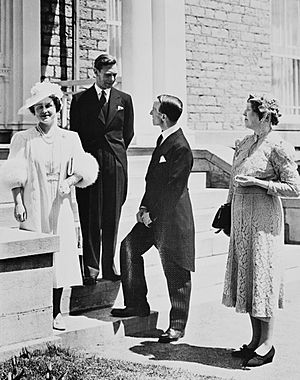
When King George VI and Queen Elizabeth visited Rideau Hall in 1939, it was a special moment. It showed that Canada was now a fully independent country. The King was the first monarch of Canada to personally welcome an ambassador there.
During World War II, some thought the King and Queen might move to Canada. This was to keep them safe from the war in Europe. However, they decided to stay in the United Kingdom to support their people.
Rideau Hall became a temporary home for many royal families during the war. These royals were displaced from their countries in Europe. They included members of the royal families of Norway, Luxembourg, Yugoslavia, Greece, Austria, and the Netherlands. The governor general's wife, Princess Alice, Countess of Athlone, helped organize efforts to make clothes for those affected by the war. In 1940, the governor general's office moved to Rideau Hall. In 1941, Winston Churchill, the British Prime Minister, even held meetings from his bed at Rideau Hall.
After the War
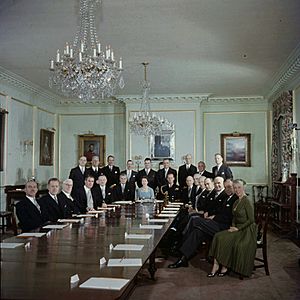
After the war, life at Rideau Hall returned to normal. The first peacetime ball was held for U.S. President Dwight D. Eisenhower. In 1952, Vincent Massey became the first Canadian-born governor general. He was also the first single person to hold the role.
The number of official events at Rideau Hall grew in the 1950s and 1960s. Canada's role in the world became more important. Many world leaders visited, including Queen Juliana of the Netherlands and Emperor Haile Selassie I of Ethiopia. More members of Canada's royal family also visited. In 1957, Queen Elizabeth II stayed at Rideau Hall as Queen for the first time. She gave her first live television address to Canadians from there.
During the October Crisis in 1970, Rideau Hall was heavily guarded. This was due to security concerns in Quebec.
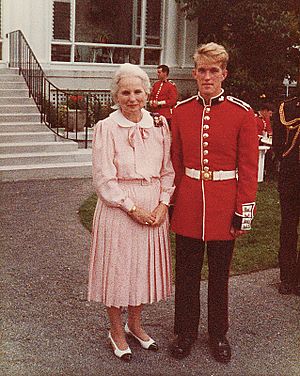
From 1984 to 1990, during Jeanne Sauvé's time as governor general, public access to the grounds was limited. This was for security reasons. However, her successor, Ray Hnatyshyn, reopened the grounds to the public.
Rideau Hall Today

In recent years, Rideau Hall has continued to be a busy place. When Julie Payette became governor general in 2017, renovations were happening. She lived at 7 Rideau Gate nearby during this time. The private apartments were being updated to feel more private.
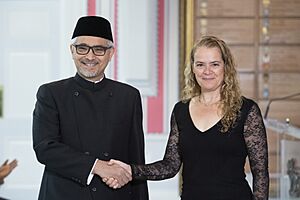
The grounds were closed for much of 2020 due to the COVID-19 pandemic. On July 2, 2020, an intruder drove onto the grounds. He was arrested without harm. Neither the Governor General nor the Prime Minister were at Rideau Hall at the time.
What Happens at Rideau Hall?

Rideau Hall is mainly the home and office of the governor general. It also houses the Canadian Heraldic Authority. When the King of Canada is in Ottawa, this is his home too. A team of staff, like chefs and aides, helps support the governor general and the King.
Most of the building is used for official events. About 200 events happen at Rideau Hall each year. Many of these are ceremonies to present Canadian awards. New prime ministers and government members are sworn in here. Important election documents are also officially presented. Foreign leaders, ambassadors, and Canadian ministers meet with the governor general or the King here.
While there is a dining room, large dinners are usually held in the ballroom or tent room. The food and wines served are always Canadian.
The residence is open to the public. Free tours of the state rooms are offered all year. Educational tours are also available for students. It is the only official residence in the National Capital Region that the public can visit. A visitor centre is located near the main gate. Rideau Hall also takes part in Doors Open Ottawa each year. Children can even trick-or-treat at the house on Hallowe'en.
Building Design
The original house built in 1838 by Thomas McKay was small. It had two floors and a curved front. McKay designed it in a Regency style. The main entrance was on the west side. Rooms for living and entertaining were spread out.
Rideau Hall has been expanded many times since it was first rented. In 1865, the first addition was made. A long wing was added to the east. It was built to look like the governor general's home in Quebec. This part was designed in a Norman style.
In 1872, an indoor tennis court and a ballroom were added. The ballroom was built with strong timber and stone. In 1898, the Minto wing was built on the east side. This was for the large family of the Earl of Minto. Later, the Earl Grey added the governor general's study.
A big change happened in 1913 with the Mappin block. This part connected the ballroom to the tennis court (now the tent room). It was designed in a Florentine architectural style. The Mappin block is three stories tall. Its front has columns and windows with special designs. The Royal Arms of the United Kingdom are carved above the main entrance.
Rideau Hall's main entrance is part of the Mappin block. On July 1, 2017, it was named the Queen's Entrance. This was to honour Queen Elizabeth II. The doors have bronze designs that represent Canadian history. The handles look like twigs. Inside, the push-plates have parts of the Arms of Canada carved into them.
The entrance also has a covered driveway called a porte-cochère. It has three arched openings. The middle arch has a carved stone shield of the Arms of Canada from 1868. In winter, glass doors can be added to keep the space warm.
The third floor of the Mappin block has apartments for aides-de-camp. From there, you can reach the flagpole.
Other projects included enlarging the dining room in 1912. The long gallery was also added. In 1927, a simple verandah was built. It has large windows overlooking the lawn.
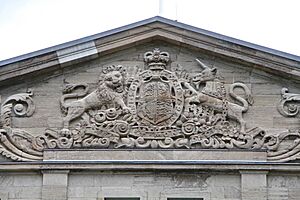
An accessible entrance, named after Princess Anne, was added in 1982. The Minto wing was changed from homes to offices. In 2006 and 2007, the main front of Rideau Hall was renovated. The stone was cleaned, and windows were repaired. A new climate control system was started in 2012. It uses geothermal heating to heat and cool the building.
In 1986, Rideau Hall was named a classified heritage property. This means it is very important to Canada's history.
Inside Rideau Hall
Rideau Hall has many Canadian art pieces and furniture. In the past, the inside changed with each new governor general's family. They would update the house to their liking.
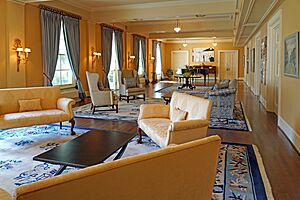
Today, the rooms have both historical items and modern Canadian art. The long gallery has Chinoiserie decorations. These were collected by the Marchioness of Willingdon during her trip to China in 1926. This room is used to welcome ambassadors. It has carpets from the Hongkong and Shanghai Bank. It also has a piano that belonged to Glenn Gould. Other governor general's wives also left their mark. Princess Louise painted apple branches on a door. Nora Michener donated a collection of Inuit sculptures.
Governor General Adrienne Clarkson and her husband, John Ralston Saul, changed the colours of the state rooms. They used more historical colours. They also worked with a Canadian artist to create the first Canadian porcelain dinner service for Rideau Hall.
Since Vincent Massey's time, the government has helped maintain Rideau Hall. The National Capital Commission is in charge of decorating the rooms. Since 2004, they have been restoring many rooms to their original look.
Main Rooms
The reception room is the only part left of the original McKay house. It is used for small ceremonies. The royal suite, which is the King's bedroom, is directly above it. Some parts of McKay's house are still visible, like a blocked window in the reception room.
The Mappin wing has the entrance hall. Its walls are partly covered in wood and marble. A wide marble staircase connects the two levels.
In 2012, bronze handrails were added to the staircase. These improved access and celebrated Queen Elizabeth II's Diamond Jubilee. The Royal Window is a stained glass piece in the entrance hall. It celebrates Queen Elizabeth II's 40th year on the throne. It shows the Queen's Canadian royal standard and the Great Seal of Canada. Another stained glass window celebrates the first Canadian-born governor general.
The Ballroom and Tent Room
The ballroom is a very important room at Rideau Hall. It is where awards are given and government members are sworn in. It is the second most photographed room in Canada, after the House of Commons. Ambassadors present their official papers here. Large dinners are also held in the ballroom. It can seat up to 130 guests for meals. For other events, it can hold 350 people.
The ballroom has tall, arched windows and decorative columns. A large, one-ton chandelier hangs from the ceiling. It has 12,000 pieces of Waterford Crystal. The British government gave it to Canada in 1951. The north wall, called the Sovereign's Wall, displays portraits of monarchs.
The tent room is used for less formal gatherings. Its design looks like the inside of a large tent. This is because, in the past, striped fabric was draped on the walls and ceiling to make it look like a tent for parties.
Other Rooms
The Monck wing has other living areas and dining rooms for less formal events. The Pauline Vanier room is a small sitting room. It is used for informal meetings with visiting leaders. This room has furniture and art by Canadian artists.
The large drawing room is used for formal gatherings. It was updated in 1901 in the Edwardian style. Portraits of past governor general's wives hang on its walls. Across the hall is the state dining room. It is used for smaller state dinners, seating up to 42 guests. The silver sets in this room are on loan from Buckingham Palace.
The governor general's study is at the east end of the Monck wing. It has carved wood panels. The names of each governor general are listed around the room. The prime minister uses a special entrance to meet the governor general here. The library contains a full collection of books that have won the Governor General's Literary Award.
The Monck wing also has a smaller drawing room and a billiard room. The governor general's private living area is on the upper floor. Other guest bedrooms are also on this floor. Each is named after a former British governor. There is also a chapel on this floor. It was opened in 1967 by Queen Elizabeth II.
Art Collection
In the past, most art in Rideau Hall belonged to the governor general. It was removed when they left. But since the 20th century, more art has been added to the official Crown Collection. This includes paintings, sculptures, and books. Many pieces are by Canadian artists. The collection also includes art from other parts of the world. Museums and galleries also lend art to Rideau Hall.
Since Governor General Adrienne Clarkson's time, art exhibitions have been held. These shows feature Canadian artists.
The Grounds
Rideau Hall's 88-acre (36-hectare) grounds have beautiful Canadian landscapes. They include large lawns, groups of trees, and winding paths. There are over 10,000 trees on the property. A 2,500-metre (8,200-foot) long Victorian-style fence surrounds the property. The main gate and lodge were built in 1867-1868.
The site is divided into five areas: a wooded park, open parkland, a sugar bush, ornamental gardens, and a farm area. The farm used to have cattle and grow hay. Today, only vegetable and herb gardens remain. These gardens provide food for the palace kitchens. A greenhouse provides flowers for the hall. In spring, maple trees are tapped for syrup. A 1-kilometre (0.6-mile) section of the Trans Canada Trail runs through the property.
The grounds have also changed over time. Lady Byng created a rock garden. A totem pole by Kwakiutl artist Mungo Martin was gifted to the Earl Alexander of Tunis. The Fountain of Hope was built to honour Terry Fox. An inukshuk by artist Kananginak Pootoogook was built in 1997. The Canadian Heritage Garden is a rose garden.
Each royal family member or visiting leader is asked to plant a tree. There are nearly 100 such trees on the property. They have small plaques with the planter's name. These include trees planted by Queen Elizabeth II and King George VI. Many foreign leaders have also planted trees.
The gardens have hosted many activities. Early governors general added a curling rink, a skating pond, and toboggan runs. The skating pond is still used today.
The grounds of Rideau Hall have been open to the public since 1921. Today, an expanded Visitor Centre helps with tours.
Garden parties are held by the governor general in the summer. Each year, a New Year's Levée is held. This event welcomes the public for skating, sledding, and refreshments. The grounds also host cricket matches. This tradition started in 1866.
Other Buildings on the Grounds
Besides Rideau Hall itself, there are 27 other buildings. These include Rideau Cottage, which is currently a temporary home for the Prime Minister. There are also offices for the Royal Canadian Mounted Police and the National Capital Commission. Other buildings include the Governor General's Foot Guards' House, the Dome Building (built in 1877 for gas storage), the Visitors Centre, and stables. There are also six greenhouses.
Nearby Properties
St. Bartholomew's Anglican Church is across MacKay Street. It was once part of the McKay Villa estate. Governors general and their families often use this church. 7 Rideau Gate is a guesthouse for important visitors. It is located just outside the main gate of Rideau Hall.
See also
 In Spanish: Rideau Hall para niños
In Spanish: Rideau Hall para niños
- Government Houses in Canada
- List of palaces



